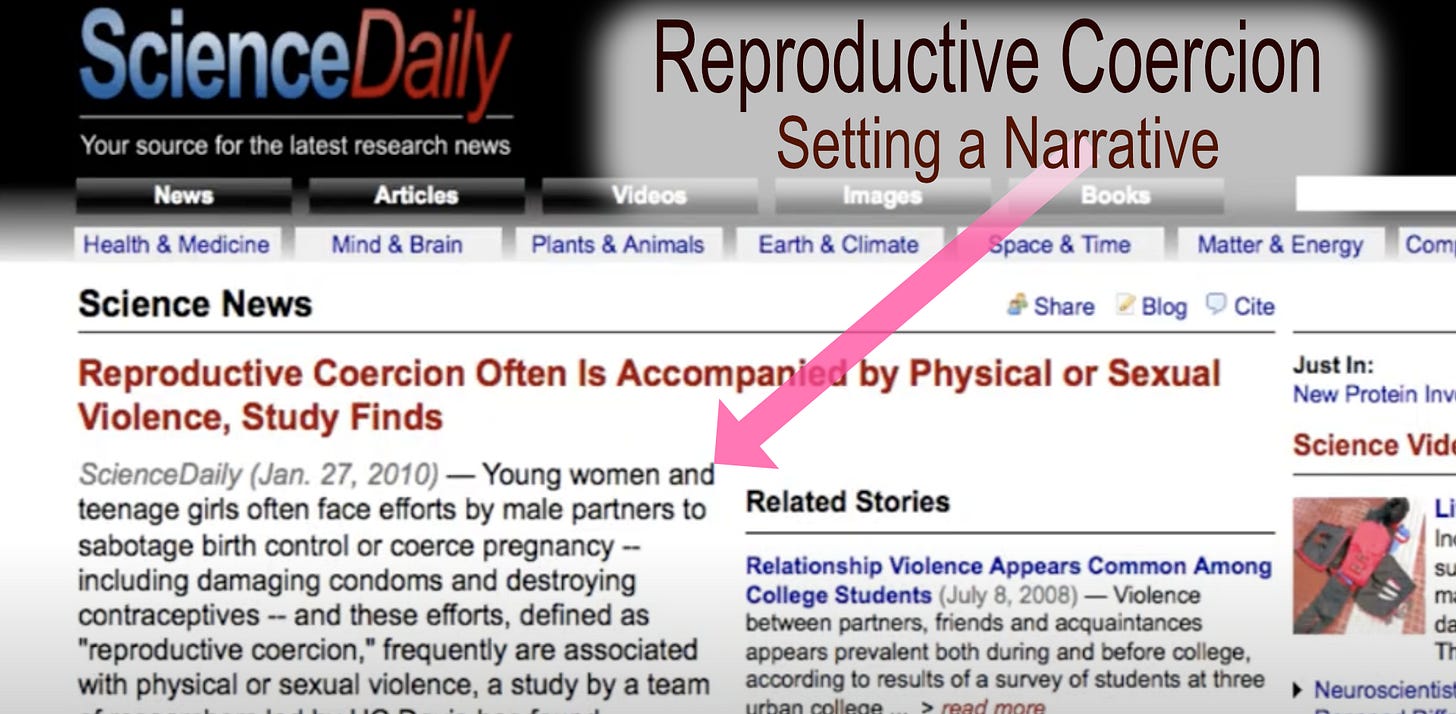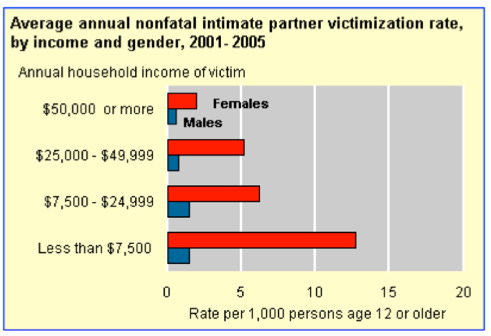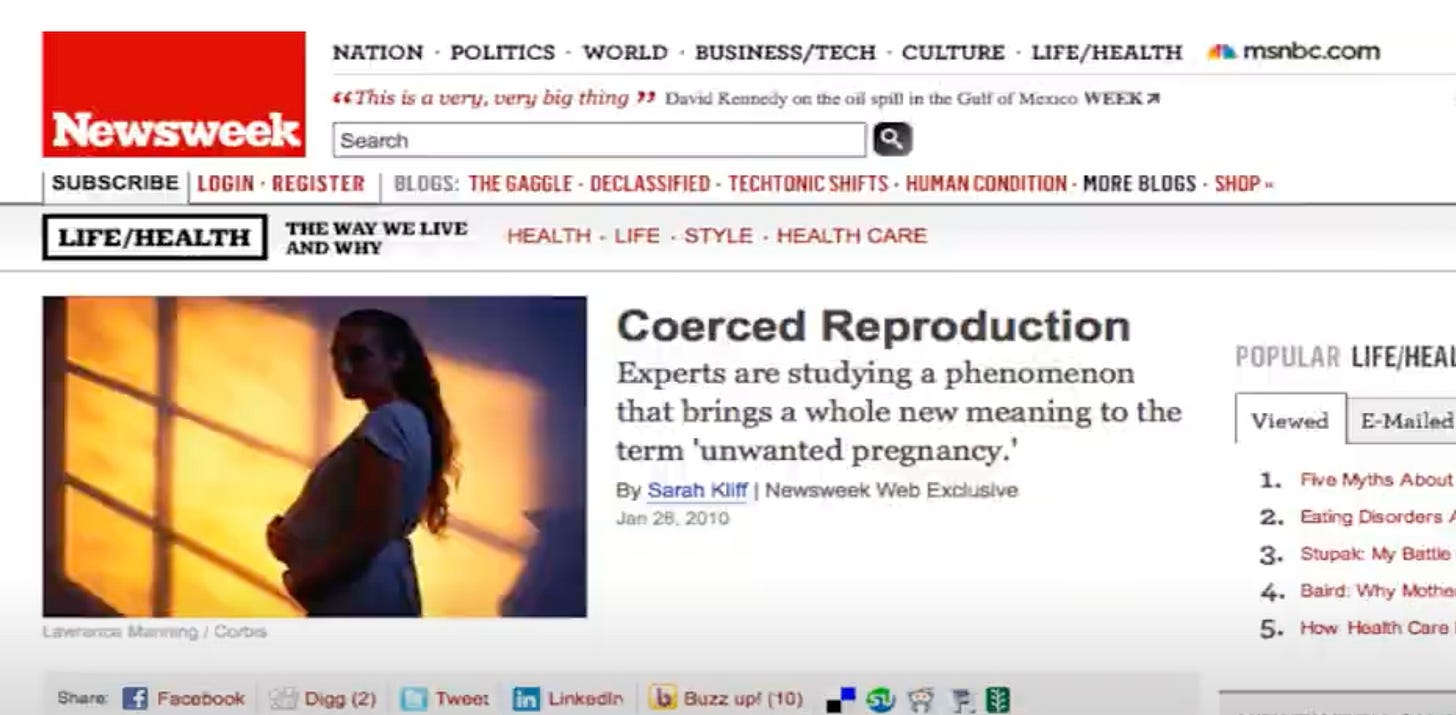This report was written some time ago but the deceit it exposes is important to grasp in order to understand how narratives are created and maintained.

I was browsing on the web and happened to read an article about a study on “Reproductive Coercion.” As I read it I was amazed at the sorts of statistics that the study was quoting. One article said that 53% of women surveyed had experienced violence in her relationships. “Wow” I thought, thatʼs over half of the respondents. Thatʼs quite a few. I read on and other stats were quoted that were equally shocking. I began to wonder about how they got such alarming statistics. My interest was stimulated and I started searching for articles on this research. There were plenty. One from Newsweek, one from Science News Daily, one from Medical News Today, one from EScience News, one from the LA Times and others. They all made similar claims about this study and often used the same quotes and the same statistics. I kept looking for more articles thinking that with statistics as strong as these that there must be something unusual here. I wondered if their sample was biased in some way or perhaps the way they had defined their terms had inflated the numbers. About the tenth article I found was one from the college newspaper of the lead researcher in the study. The publication was called “The Aggie” and was the student paper for the University of California, Davis. That article included something that the others had omitted. The Aggie article said that the survey was done on an “impoverished” population of African American and Hispanic females. It went on to say that the study should not be generalized: “The five clinics surveyed were in impoverished neighborhoods with Latinas and African Americans comprising two-thirds of the respondents. The results are expected to be applicable to reproductive health clinics in demographically poor areas. Researchers cannot estimate if surveys at private gynecologists would produce similar results.” Suddenly the results started to make more sense. We know that lower socio-economic levels tend to show much higher levels of interpersonal violence (IPV). One DOJ report shows that women with lower income levels are almost three times more likely to experience relationship violence than those with higher incomes. We know that women in rental housing are also three times more likely to experience IPV than those in homes that they own. By studying a sample that was impoverished it dramatically increased the likelihood of finding higher rates of IPV.

Then I started to wonder. How was it that all of the national media articles which had obviously been seen by millions of people had missed the sample being of impoverished African American and Hispanic females? I started to think that the media was simply not doing their homework and that their readers were getting fed misinformation as a result. I decided at that point to obtain a copy of the study. I went to the online site for the Journal Contraception which had published the original article and purchased a copy. I read it. By the end I was shocked. There was no mention in the journal article of the socio-economic status of the sample that had been surveyed. No mention of whether they were rich or poor. I had to catch myself because I had earlier assumed that it was the media not doing their homework and simply not reading the journal article. But now it was a completely different situation. The information had been omitted from the journal article. How could that be? This was an article that had 7 researchers named as co-authors. It had to have been read and edited over and over again. How could it be that something so basic would have been left out? I decided to write to the lead researcher Dr Elizabeth Miller. I sent her an email and asked about the sample. I told her that I had read the article in the Aggie that had mentioned that the sample was “impoverished” African American and Hispanic females and I was interested to know if this was correct or if the Aggie had made a mistake. She wrote me back a very pleasant email in several days apologizing for taking so long to get back to me and saying that yes, the Aggie was correct that the sample was largely disadvantaged African American and Hispanic females. I wrote her back very quickly and asked why that information had not been mentioned in the journal article. I also asked if she was concerned about the national media articles that never mentioned the fact that the sample was impoverished and seemed to be erroneously implying that the study could generalize to the population at large. She wrote me back once but has never offered any answers to those questions.
At that point I contacted Gabrielle Grow, the author of the Aggie article and congratulated her on a job well done. I asked her how she had found out about the sample being “impoverished.” She told me that it was just one of the questions that she had asked the researchers in the interview. I wrote her back and congratulated her again and explained to her that all of the national articles including Newsweek, LA Times, Science News Daily, EScience News, Medical News Today and others had all missed that important bit of information. Ms Grow was the only reporter that asked the important question. But why did the national news media not ask the same question? This is an important question and we really donʼt know the answer at this point. What we do know is the study issued a press release about the research findings and never mentioned the sample being largely a poor population. They also made no mention of the fact which is referenced in their study that this sort of population has higher reports of IPV thus creating inflated responses when compared to the general population. It made no mention that the study should be applicable only to other poor neighborhoods. Reading the press release one might easily assume that the study applied to everyone. Here are just a few of the points the press release made: 1. Men use coercion and birth control sabotage to cause their partners to become pregnant against their wills. 2. Young women and teenage girls often face efforts by male partners to sabotage their birth control or coerce or pressure them to become pregnant - including by damaging condoms and destroying contraceptives. 3. Fifty-three percent of respondents said they had experienced physical or sexual violence from an intimate partner. 4. Male partners actively attempt to promote pregnancy against the will of their female partners. With no mention in the press release that the studyʼs sample was largely indigent African American and Hispanic females one could get the impression from reading it that the study might apply to the general population. Even though the researchers when asked by Ms Grow, admitted that the study should only be applied to the poor. One can only assume that the researchers failed not only to mention this important information in the press release but also didnʼt offer this to the media in any of the interviews. Actually there was very little information offered that might have discouraged the media from playing this as a study about men and women in general.

This is obvious when you look at the headlines and quotes from various news articles. Here is a sampling: NEWSWEEK "What we're seeing is that, in the larger scheme of violence against women and girls, it is another way to maintain control," says Miller.” "The man is taking away a woman's power to decide she's not going to have a child.” LA Times “Reproductive coercion is a factor in unintended pregnancies” “Young women even report that their boyfriends sabotage birth control to get them pregnant.” ScienceDaily “Over half the respondents -- 53 percent -- said they had experienced physical or sexual violence from an intimate partner.” “The study also highlights the importance of working with young men to prevent both violence against female partners and coercion around pregnancy.” Physorg “Approximately one in five young women said they experienced pregnancy coercion” ESCIENCE NEWS “Young women and teenage girls often face efforts by male partners to sabotage birth control or coerce pregnancy — including damaging condoms and destroying contraceptives” INSCIENCES “This study highlights an under-recognized phenomenon where male partners actively attempt to promote pregnancy against the will of their female partners,” said lead study author Elizabeth Miller, a Medical News Today Headline - Physical or Sexual Violence Often Accompanies Reproductive Coercion End Abuse . org “It finds that young women and teenage girls often face efforts by male partners to sabotage their birth control or coerce or pressure them to become pregnant – including by damaging condoms and destroying contraceptives.”

What do these quotes and headlines have in common? They all sound as if the study in question applies to the general population of men and women, boys and girls. The circulation of Newsweek is 2.7 million so just from that source alone a great many people have been given the impression that men in general will tend to coerce women in general to get pregnant. The first level is the research paper itself. The Contraception Journal was obviously read by many, especially other researchers. Then the next level is the national media that wrote stories about the study. We saw above some of the sorts of misrepresentations that were common from the national media articles. But things go even further. Once the journal article is published and then the media articles follow there is a third wave that hits: the blogs. When end users hear this sort of thing they take it a step farther. Here are just a few examples of what happens: Hereʼs a headline from a blog:
Crazy, Condom-Puncturing Control Freaks Are Often Men
So we have gone from omitting the nature of the sample to the printing of articles in the national media that implicate men in general and once this happens the end users at the blogs take that information and exaggerate it much farther. Hereʼs another example:
There is a new study which discusses a horribly prevalent but rarely discussed form of intimate partner violence: reproductive coercion.
So we have gone from low income Black and Hispanic females claiming to be coerced to making global pronouncements about reproductive coercion being “horribly prevalent.” Right. Those crazy condom puncturing control freaks are part of a horribly prevalent pattern. It doesnʼt take much imagination to see the next step of a dinner table discussion of this issue. The daughter announces at the table that it is men who puncture condoms and force women into pregnancy. Mom tells her that that couldnʼt be and the daughter pulls up a link to the blog and then to the Newsweek article. Dad is still unimpressed until she pulls up a link to the study which partially verifies her false claim. All at the table are convinced now it is the men in general who are coercing women into pregnancy. This is the way memes get started. A “research” article tells half the story and the partial data is misinterpreted unknowingly by the media who then pass on the half story as truth to unwitting millions who hear the medias version and their claim that it is research driven and the public is sold. It must be true! This is of course what happened with domestic violence. Early feminist researchers only told half the story, that women were victims of domestic violence and men were perpetrators. The media simply passed on the story to millions and the rest is history. We have a general public who is convinced that it is only women who are victims of domestic violence.
The scientific method is very clear. You create a hypothesis and find a way to test it. You then carefully sift though the test data and account for the data that affirms your hypothesis and importantly account for the data that conflicts with your hypothesis. What has happened over and over from feminist researchers is simply ignoring the data that conflicts with your hypothesis (male victims) and focusing solely on that data that confirms your ideology (female victims). Interestingly in this study the researchers failed to ask the subjects if they had also coerced their male partners. They only asked the questions that would provide them with the “acceptable” answers. In the study examined in this article the researchers seem to have “forgotten” to remind the media of the limitations of their sample. In a similar fashion to the first study, the press release seems to have been used to steer the data. One could assume that leaving out the nature of the sample was an honest mistake. If so, I would have expected Dr Miller to respond to my email asking about the omission of the nature of the sample. But she did not. This leaves us not knowing if the mistake was or was not intentional. Perhaps we will never know. I know what my guess is. Whatʼs yours?


















